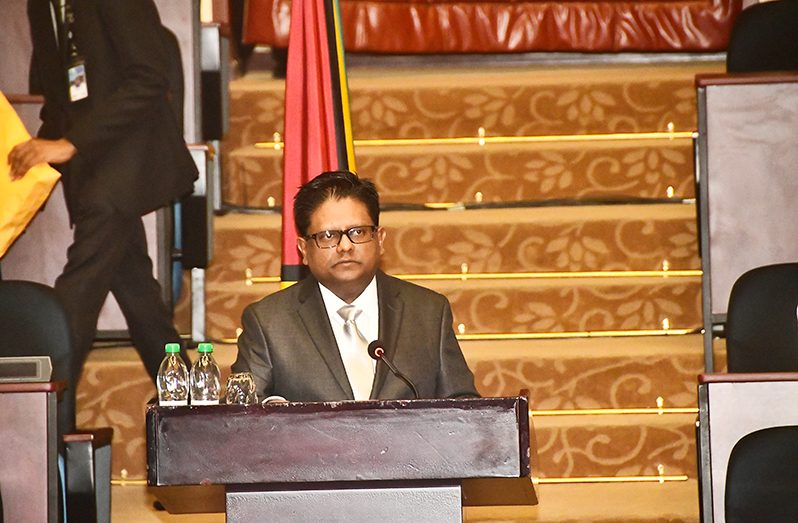–with increases in old-age pension, income tax and public assistance; extension of adjustment in freight charges, among other measures
SOME $50 billion will be placed in the pockets of citizens through the proposed increases in old-age pension, public assistance and income tax threshold, along with other cost of living measures that form part of the government’s $781.9 billion budget for 2023 that was tabled in the National Assembly, on Monday.
Released under the theme, “Improving lives today, building prosperity for tomorrow,” this year’s budget is the largest budget ever, and despite being 41.4 per cent larger than Budget 2022, it is fully financed with no new taxes.
“Budget 2023 strikes a balance between addressing the pressing needs of today and the critical investments needed for tomorrow, ensuring that both are attended to,” Senior Minister with Responsibility for Finance, Dr. Ashni Singh, said as he presented the milestone budget.
He went on to say: “Budget 2023 also reflects a number of measures that are geared towards providing further stimulus to economic activity and the productive sectors, as well as to bring relief to households and individuals.
“These interventions are targeted towards continuing to increase the disposable income of our citizens, while facilitating and promoting job creation and income generation, coupled with an institutional framework that will reduce the cost of doing business all with the aim of improving the lives of all Guyanese.”
The income tax threshold was increased by another $10,000, moving from $75,000 to $85,000. As a result of the adjustment in the tax threshold, over 12,000 persons will be removed from paying income taxes, while every single taxpayer will benefit.
This will result in a $3.3 billion increase in disposable income. At an individual taxpayer level, for illustrative purposes, this translates to additional disposal income of $33,600 annually for every single taxpayer who is currently earning $100,000 per month.
Aside from the increased income tax threshold, the first phase of salary adjustments announced last year by President, Dr. Irfaan Ali will take effect from this month, benefitting over 5,000 healthcare workers and almost 9,000 members of the Disciplined Services, resulting in an additional $3 billion in disposable income in the hands of these workers. Provision for these are all made out in Budget 2023.
Another $10 billion has also been allocated to the part time job programme which was started in 2022. The beneficiaries of this programme are encouraged to upskill themselves so they can eventually take up full-time employment as the labour market is confronted with a shortage of skills in certain areas.
Meanwhile, with effect from January 1, 2023, old-age pension will be increased to from $28,000 to $33,000.
“This measure will benefit approximately 73,000 pensioners, each of whom will now receive an additional $60,000 per annum, thereby placing an additional $4.4 billion of disposable income in their hands. With this latest increase, the total Old age pension now amounts to $28.9 billion,” Dr. Singh shared.
Public assistance was increased from $14,000 to $16,000 with effect from January 1, 2023. Over 29,000 persons, are set to benefit from this initiative, which will provide over $700 million in additional disposable income to these individuals.
Increasing old age pension and public assistance, were just two in a range of measures that the government implemented to ease cost of living.
Dr. Singh shared that the adjustment of freight charges to the pre-pandemic levels has been extended for a further 12-month period from January 1, 2023 to December 31, 2023, at a cost of over $6 billion. The zero excise taxes on fuel will also be maintained as long as fuel prices remain elevated. Some $5 billion has also been set aside for cost of living measures to be determined after community engagements.
The low-income mortgage ceiling has also been increased to $20 million, up from $15 million, reducing the cost of borrowing within this range from the commercial banks, and further incentivising home ownership.
Also in support of government’s aggressive housing drive, and to reduce the cost of home ownership, the 14 per cent VAT with respect to the sale of residential properties has been removed, which will also further reduce the cost of home ownership.
The government has also implemented measures to incentivise the transition to lower emission vehicles, with the removal of the 14 per cent VAT on new fully electric motor vehicles of any power rating, and an increase in the writing down allowance applicable to all electric motor vehicles to 50 per cent annually.
In making vehicle ownership cheaper, the government has reduced the duty from 45 per cent to 35 per cent on the importation of new motor vehicles below 1500 cc, which will reduce the cost of importing such a vehicle by approximately $200,000.
In relation to used vehicles below 1500 cc, the government will be replacing the current tax rate with a flat rate of taxes of $800,000, which will reduce the cost of importing such a vehicle by $300,000 on average.
“An aggregation of these measures will place over $50 billion in the hands of citizens, easing cost of living pressures while incentivising the expansion of economic activity and job creation,” Dr. Singh said.




.jpg)









